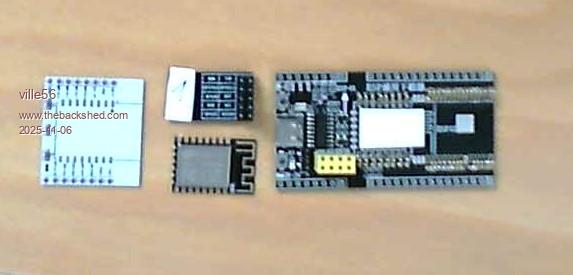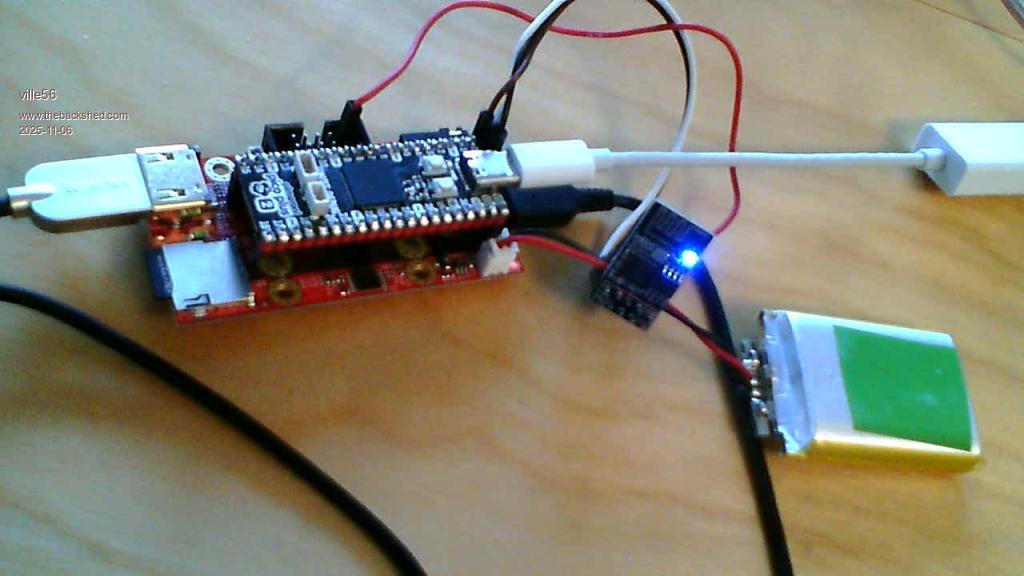
|

|
Forum Index : Microcontroller and PC projects : WLAN console
| Author | Message | ||||
| ville56 Senior Member Joined: 08/06/2022 Location: AustriaPosts: 268 |
for whom it may be of interest .... I've managed to get WLAN console access (telnet) to a non-W pico. My solution is to use a ESP8266 module and some free software. Connection is made to the module via the pico console UART pins. ESP-Software: I was successful using ESP01+/ESP12F modules with a software called ESP-Link which can be found on https://www.zuidwijk.com/using-esp-link/ This software converts a ESP8266 module into a Telnet-to-serial converter. The module is connected to the Pico via TXD/RXD and 3.3V/GND. Baudrate set to 115200 works. One can connect via WLAN and Telnet to the module which acts then as a transparent bridge. I've tried it with MMCC and putty (both via telnet and via virtual com-port), both work without any problems. Config of the ESP-Link module is via Telnet and relatively easy and self explanatory. The website gives good instructions on how to flash and use it. A flasher is also included on the website. ESP-Hardware: Tried it on ESP01+ and ESP12F modules with 4Mb (32Mbit) of flash and it works, but I couldn't get it running on the standard ESP01/ESP01S modules with 1Mb (4Mbit) flash!!! The ESP-01+ modules are easy to work with, as they have standard 0.1 Inch pinout, the ESP12F have a smaller pinout as they are SMD, but adapters are available to 0.1 Inch. ESP programming: A programming adapter is needed for that. They can be found on Amazon/ebay and should come with a programming button (not the switch). This ensures that the required programming hardware is on the adapter. Otherwise it gets a bit complicated to program. The ESP01+ do have a 10 pin header instead of the usual 8-pin header of the adapters, but can be inserted into the adapter by leaving the GPIO4/GPIO5 row out. So far one can access the pico console via telnet. Windows software: If one decides to have not only Telnet access but needs a true COM-port in Windows you can do that with com0com and hub4com, both available on Github. com0com creates a pair of virtual com-ports and hub4com is able to forward a com-port to telnet. So the hub4com connects to a com-port created with com0com and the application connects to the other com-port of that pair. Additionally hub4com is able to send NOP messages on the telnet side to prevent the ESP-Link module to go to sleep and thus terminating the windows service, if established (see below). Windows service WinSW: As the hub4com is a commandline tool, it leaves a console window open in windows. This can be circumvented by using WinSW (Windows service wrapper), a conveniant tool to convert a commandline tool into a service-like app, autostarting on boot and can be managed with the windows service tools. I've used this tool for netork-Hamlib access to my transceivers for a long time already and it works reliably. The tool can also be found on Github. For me it works reliably now, uploading/downloading to the Pico is no problem and also editing works. Firmware updates still require physical access. below are some pictures of the modules in use:  left side: ESP12F adapter to 2,54 mm middle top: ESP01+ with 10-pin header middle-bottom: ESP12F SMD module right side: universal programming adapter for ESP01+ (yellow header) and ESP12F (can be inserted into the spring contacts). After soldering into the adapter only some jumper wires help to reprogram the ESP12F, of course ....  My test-setup with a Pico HDMI and a ESP01+ adapter  I've tested it only on W11, it should work similarily on Linux but I have no environment to test it. If there are questions, please ask .... Gerald 73 de OE1HGA, Gerald |
||||
| dddns Guru Joined: 20/09/2024 Location: GermanyPosts: 693 |
Hello Gerald, I wanted to try that too and with the next chance I'll order 2 of them. For Linux I saw "ser2net" package which I think will do the translation. There is another project with two 8266 connect under each other and you have transparent RXD/TXD. I want to try that too. Your setup with the Olimex and PicoPlus is great! |
||||
| ville56 Senior Member Joined: 08/06/2022 Location: AustriaPosts: 268 |
Hi Dietmar, you should be able to configure 2 ESP-Link modules also for transparent rx/tx connection. One as access point, one in station mode. Haven't tried it yet, but it should do. For the ESP01+ i used "ei-ot.de" as supplier. Shold be conveniant for you as well. If you just want telnet access to the console port you don't need nothing alse but the programmed module. Only if you want a com-port on your PC/server to access the console then you have to use some "com-to-telnet" software. Gerald 73 de OE1HGA, Gerald |
||||
| dddns Guru Joined: 20/09/2024 Location: GermanyPosts: 693 |
Hello Gerald, can you already tell about the error rate and how it performs under some load like Autosave? Another interesting shop for our region |
||||
| ville56 Senior Member Joined: 08/06/2022 Location: AustriaPosts: 268 |
Dietmar, I do not expect to see any errors (as counters) as the telnet protocol is on top of TCP/IP which should handle any transmission errors. So at worst, this would mean a connection abort but only in case of unrecoverable errors ... simply spoken. And honestly I do not know how to read out the TCP/IP error counters in windows. What I will do tomorrow (if my time allows it) is to make some measurements of transfer times with TeraTerm as client and with XMODEM and YMODEM. XMODEN just got stuck on the HDMI pico at packet # 255, which is reproducable. YMODEM is not implemented on HDMI, so i have to change the HW setup first to make some reliable test. It seems to work with AUTOSAVE N as MMCC is using that. Basically I expect some transfer speed penalty against a USB connetion as with the ESP module the connection speed to the pico is the baudrate specified (e.g. 115200) whereas on an USB virtual com-port it transfers as fast as both sides allow it, whatever the baudrate is. Gerald 73 de OE1HGA, Gerald |
||||
| The Back Shed's forum code is written, and hosted, in Australia. | © JAQ Software 2025 |